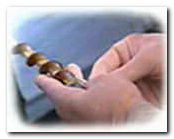Safety Product Category
Safety Cord Blood Collection
Following the delivery of a child, several samples of umbilical cord blood are taken for testing. This is typically done by cutting the umbilical cord and inserting a large gauge needle into the cord to draw a sample. Newer technologies eliminate this needlestick risk.

Umbilical cord blood is frequently drawn in order to perform a number of general purpose diagnostic tests in the 4 million births in the US each year. Test that are commonly performed on the umbilical cord blood include routine blood work such as blood type, blood pH, CBC, etc.
When a baby is delivered, the umbilical cord is typically clamped and cut. Before the placenta is delivered, the obstetrician or midwife inserts a blood bag needle into the umbilical vein. The blood flows into the bag by gravity until the umbilical cord is completely drained. The blood bag is clamped, sealed and labeled. This umbilical cord blood collection typically takes 2-4 minutes.
Newer technologies exist that take the risk of a needlestick injury out of this procedure.

